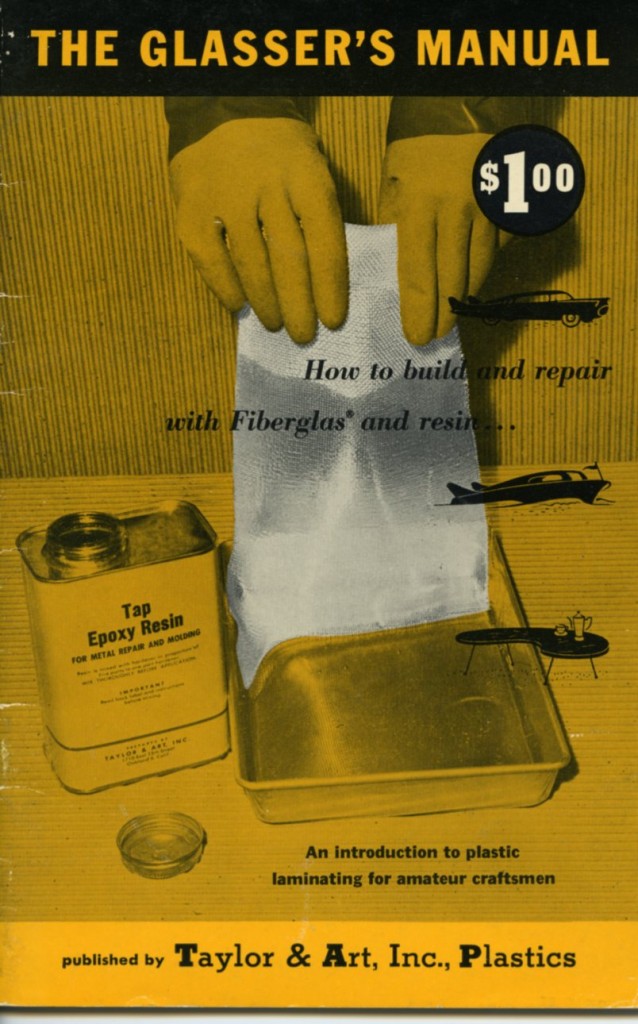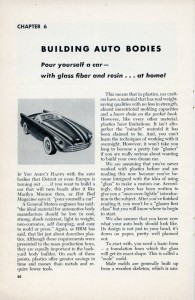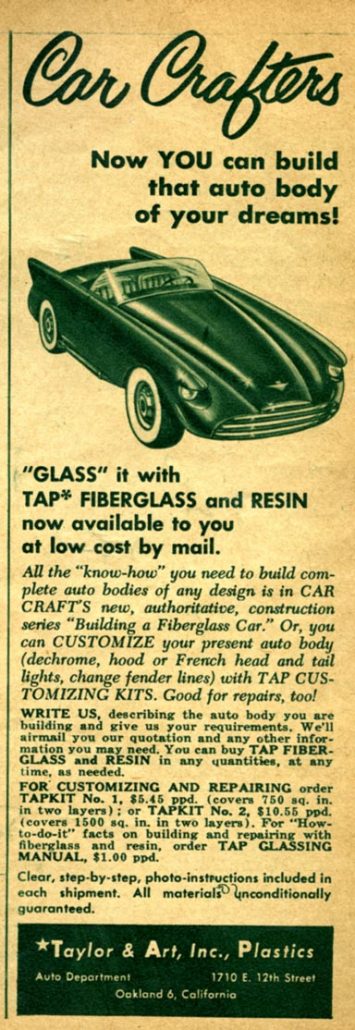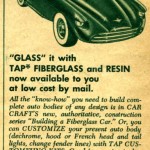
Hi Gang…
Who were the heavyweights for fiberglass supply in the 1950’s?
You’ve heard some of the names before such as Naugatuck Chemical, Owens Corning, Hollywood Plastics, Allied Fiberglass Products, and other companies too. But who would you buy from if you were embarking on the task of building a fiberglass car for the first time? How about “Taylor & Art, Inc, Plastics.”
I’ve mentioned this company in past stories – referencing both a book that they produced as well as a car that was built (the Dick Williams Special). Click here to review these past stories on Taylor & Art, Inc Plastics. Today I want to talk a bit about the advertising they did and the book that they wrote – all in the 1950’s.
Taylor & Art, Inc. Plastics Advertising
I’m still collecting ads from 1950’s fiberglass companies. Taylor & Art Plastics ads were very creative. Here’s one that I found that uses a drawing of a car that almost, from the front, looks like a Sorrell SR-100. And there’s a reason why – during the time that their book was being written, a famous series of articles about “building a fiberglass car” came out in Car Craft Magazine – and these articles featured a Sorrell SR-100.
No doubt they wanted to link the article in Car Craft with those inspired to build cars like the Sorrell SR-100. More about that in future stories here on Forgotten Fiberglass. For now, check out the copy of the Taylor & Art Plastics ad:
“Glass” it with TAP Fiberglass and Resin – Now Available To You At Low Cost By Mail
All the “know-how” you need to build complete auto bodies of any design is in Car Craft’s new, authoritative, construction series “Building a Fiberglass Car.” Or, you can CUSTOMIZE your present auto body (dechrome, hood or French head and tail lights, change fender lines) with TAP CUSTOMIZING KITS.
Good for repairs, too!
So….what is a TAP Customizing Kit? Let’s find out!
Customizing Is Easy With TAPKITS
Checkout the postcard from Taylor & Art Plastics from the 1950’s:
The back of the postcard shows the following:
This cool custom was once a 1951 Kaiser! It’s owner, Johnny Johnson of Oakland, California completely customized it himself with a TAP fiberglassing Kit. This car has been featured in Motor Life and Speed Mechanics and is winning awards and attention everywhere.
Dear Customizer – Don’t just dream about your custom. With TAPKITS, you can restyle any car without a torch, for just a few bucks. Get goin’, man! TAP
The Glasser’s Manual: Taylor & Art, Inc., Plastics (1956)
Throughout the early 1950’s, a number of different companies produced books on how to build a fiberglass car – starting with Eric Irwin (of Lancer fame) in August 1952.
Click here to review a story on all of the fiberglass books available in the 1950’s.
“The Glasser’s Manual” (1956) by Taylor & Art, Inc., Plastics was an excellent book that covered materials, method, repair, restyling, building, boats, furniture, and other areas of interest – all in just under 40 pages. One of the interesting aspects of this manual is that it covers custom work completed by Joe Bailon – a legendary California customizer whose work is celebrated today across the custom car world.
Pictures of a custom job he did on the rear fins of a Cadillac are shown, and techniques he used and developed are shared. For you Joe Bailon fans out there – this is a treat! The section dedicated to “Building Auto Bodies” is excellent as well and walks you thru the major steps you would have to take in order to design, build, and mold a fiberglass sports car body.
Let me share a bit with you from the chapter on building a fiberglass body:
 Chapter 6: Building Auto Bodies
Chapter 6: Building Auto Bodies
Pour Yourself A Car – With Glass Fiber and Resin… At Home!
If you aren’t happy with the auto bodies that Detroit or even Europe is turning out… if you want to build a car that will turn heads after it like Marilyn Monroe then, as Hot Rod Magazine (HRM) says it: “Pour Yourself A Car!”
A General Motors engineer has said: “the ideal material for automotive body manufacture should be low in cost, strong, shock resistant, light in weight, non-corrosive, self damping, and easy to mold or press.” Again, as HRM has said, that list just about describes plastics.
Although these requirements were presented to the mass production boys, they are equally important to the backyard body builder. On each of these points, plastics offer greater savings in time and money than metals and require fewer tools.
This means that in plastics, car crafters have a material that has real weight-saving qualities with no loss in strength, almost unrestricted molding capacities, and a lower drain on the pocket book. However, like every other material, plastics have limitations. 
It isn’t altogether the “miracle” material it has been claimed to be. And, you can’t learn the techniques of working with it overnight. However, it won’t take you long to become a pretty fair “glasser” if you are really serious about wanting to build your own dream car.
We are assuming that you’ve never worked with plastics before and are reading this now because you’ve become intrigued with the idea of using “glass” to make a custom car. Accordingly, this piece has been written to give you a “once-over-lightly” introduction to the subject. After you’ve finished reading it, you won’t be a “glasser first class” but you will know where to begin to start.
The chapter continues on and provides an excellent introduction to the steps needed to create a fiberglass sports car body.
Summary:
Taylor & Art, Inc., Plastics is still with us today, and have done very well over the years. One change though – they have a new shortened name – TAP Plastics. Click here to check out the history of their company and click on this link to go to their home page and explore their products and services.
I spoke with the president of TAP Plastics today, Dave Freeberg, about our interest in the early years of his company and Dave was kind enough to offer some help in locating other interesting early pieces of their company’s history. So keep your fingers crossed gang – we may have some more vintage articles on the early years of TAP Plastics heading your way.
Hope you enjoyed the story, and until next time…
Glass on gang…
Geoff
——————————————————————-
Click on the Images Below to View Larger Pictures
——————————————————————-















This site is protected by reCAPTCHA and the Google Privacy Policy and Terms of Service apply.